Podcast: Play in new window | Download (Duration: 16:04 — 18.3MB)
This week let’s find out what lived before the Cambrian explosion!
A very happy birthday to Isaac!
Further reading:
Say Hello to Dickinsonia, the Animal Kingdom’s Newest (and Oldest) Member
Charnia looks like a leaf or feather:
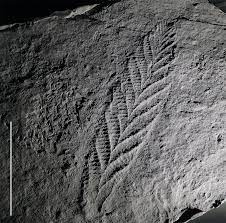
Kimberella looks like a lost earring:
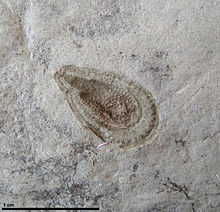
Dickinsonia looks like one of those astronaut footprints on the moon:
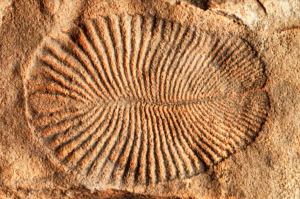
Spriggina looks like a centipede no a trilobite no a polychaete worm no a
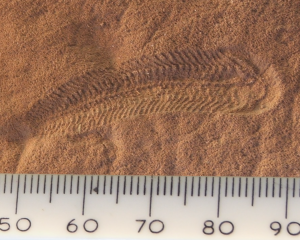
Glide reflection is hard to describe unless you look at pictures:
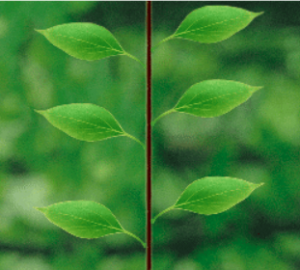

Trilobozoans look like the Manx flag or a cloverleaf roll:
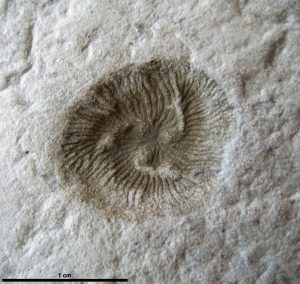
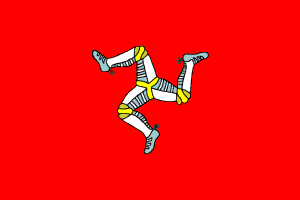

Cochleatina looked like a snail:
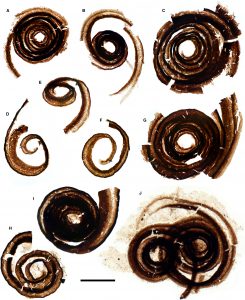
Show transcript:
Welcome to Strange Animals Podcast. I’m your host, Kate Shaw.
It’s the last week of August 2022, so let’s close out invertebrate August with a whole slew of mystery fossils, all invertebrates.
But first, we have a birthday shoutout! A humongous happy birthday to Isaac! Whatever your favorite thing is, I hope it happens on your birthday, unless your favorite thing is a kaiju attack.
We’ve talked about the Cambrian explosion before, especially in episode 69 about some of the Burgess shale animals. “Cambrian explosion” is the term for a time starting around 540 million years ago, when diverse and often bizarre-looking animals suddenly appear in the fossil record. But we haven’t talked much about what lived before the Cambrian explosion, so let’s talk specifically about the Ediacaran (eedee-ACK-eron) biota!
I was halfway through researching this episode when I remembered I’d done a Patreon episode about it in 2021. Patrons may recognize that I used part of the Patreon episode in this one. You’d think that would save me time but surprise, it did not.
The word Ediacara comes from a range of hills in South Australia, where in 1946 a geologist noticed what he thought were fossilized impressions of jellyfish in the rocks. At the time the rocks were dated to the early Cambrian period, and this was long before the Cambrian explosion was recognized as a thing at all, much less such an important thing. But since then, geologists and paleontologists have reevaluated the hills and determined that they’re much older than the Cambrian, dating to between 635 to 539 million years ago. That’s as much as 100 million years before the Cambrian. The Ediacaran period was formally designated in 2004 to mark this entire period of time, although fossils of Ediacaran animals generally start appearing about 580 million years ago.
Here’s something interesting, by the way. During the Ediacaran period, every day was only 22 hours long instead of 24, and there were about 400 days in a year instead of 365. The moon was closer to the earth too. And life on earth was still sorting out the details.
Fossils from the Ediacaran period have been discovered in other places besides Australia, including Namibia in southern Africa, Newfoundland in eastern Canada, England, northwestern Russia, and southern China. Once the first well-preserved fossils started being found, in Newfoundland in 1967, paleontologists started to really take notice, because they turned out to be extremely weird. The fossils, not the paleontologists.
Many organisms that lived during this time lived on, in, or under microbial mats on the sea floor or at the bottoms of rivers. Microbial mats are colonies of microorganisms like bacteria that grow on surfaces that are either submerged or just tend to stay damp. Microbial mats are still around today, usually growing in extreme environments like hot springs and hypersaline lakes. But 580 million years ago, they were everywhere.
One problem with the Ediacaran biota, and I should explain that biota just means all the animals and plants that live in a particular place, is that it’s not always clear if a fossil is actually an animal. Many Ediacaran fossils look sort of plant-like. At this stage, the blurry line between animals and plants was even more blurry than it is now, with the added confusion that sometimes non-organic materials can resemble fossils, and vice versa.
For instance, the fossil Charnia, named after Charnwood Forest in England where it was first discovered. In 1957, a boy named Roger, who was rock-climbing in the forest, found a fossil that looked like a leaf or feather. He took a rubbing of the fossil and showed his father, who showed it to a geologist. The year before, in 1956, a 15-year-old girl named Tina saw the same fossil and told her teacher, who said those rocks dated to before the Cambrian and no animals lived before the Cambrian, so obviously what she’d found wasn’t a fossil.
Tina’s teacher was wrong about that, of course, although he was correct that the rocks dated to before the Cambrian, specifically to about 560 million years ago. But while Charnia looks like a leaf, it’s not a plant. This was about 200 million years before plants evolved leaves, and anyway Charnia lived in water too deep for plants to survive. It anchored itself to the sea floor on one end while the rest of the body stuck up into the water, and some specimens have been found that were over two feet long, or 66 cm. Some researchers think it was a filter feeder, but we have very little evidence one way or another.
One common animal found in Australia and Russia is called Kimberella, which lived around 555 million years ago and might have been related to modern mollusks or to gastropods like slugs. It might have looked kind of like a slug, at least superficially. It grew up to 6 inches long, or 15 cm, 3 inches wide, or 7 cm, and an inch and a half high, or 4 cm, which was actually quite large for most animals that lived back then. It was shaped roughly like an oval, with one thin end that stuck out, potentially showing where its front end was, although it didn’t have a head the way we think of it today. The upper surface of its body was protected by a shell, but not the type of shell you’d find on the seashore today. This was a flexible, non-mineralized shell, basically just thick, toughened tissue with what may be mineralized nodules called sclerites embedded in it. All around its body was a frill that might have acted as a gill. The underside of Kimberella was a flat foot like that of a slug.
We know Kimberella lived on microbial mats on the sea floor, and it might have had a feeding structure similar to a radula. That’s because it’s often found associated with little scratches on its microbial mat that resemble the scratches made by a radula when a slug or related animal is feeding on a surface. The radula is a tongue-like organ studded with hard, sharp structures that the animal uses to scrape tiny food particles from a surface.
Kimberella displays bilateralism, meaning it’s the same side to side. That’s the case with a lot of modern animals, including all vertebrates and a lot of invertebrates too, like insects and arachnids. But other Ediacarans showed radically different body plans. Charnia, for instance, exhibits glide reflection, where both sides are the same as in bilateralism, but the sides aren’t exactly opposite each other. If you walk along a beach and make footprints in the sand, your trail of footprints actually demonstrates glide reflection. If you stand on the sand and jump forward with both feet together, your footprints demonstrate bilateralism since the prints are side by side. (This is confusing to describe, sorry.) Pretty much the only living animals with this body pattern are some sea pens, which get their name because they resemble old-fashioned quill pens. Many sea pens look like plants, and for a long time researchers thought Charnia might be an ancient relation to the sea pen. These days most researchers are less certain about the relationship.
A similar-looking animal that lived around the same time as Charnia was Dickinsonia. It looks sort of like a leaf too, but a more broad oval-shaped leaf instead of a long thin one like Charnia. It’s also not a leaf. Some are only a few millimeters long, but some are over 4 1/2 feet long, or 1.4 meters.
Dickinsonia may be related to modern placozoans, a simple squishy creature only about one millimeter across. It travels very slowly across the sea floor and absorbs nutrients from whatever organic materials it encounters. But we don’t know if Dickinsonia was like that or if it was something radically different. Until a few years ago a lot of paleontologists thought Dickinsonia might be some kind of early plant or algae. Then, in 2016, a graduate student discovered some Dickinsonia fossils that were so well preserved that researchers were able to identify molecular information from them. They found cholesteroids in the preserved cells, and since only animals produce cholesteroids, Dickinsonia was definitely an animal. But that’s still about all we know about it so far.
Spriggina is another animal that at first glance looks like a leaf or feather. Then it sort of resembles a trilobite, or a segmented worm, or a possible relation to Dickinsonia. It looks like all sorts of animals but doesn’t really fit with anything known. It grew up to two inches long, or 5 cm, and had what’s referred to as a head shield although we don’t know for sure if it was actually its head. The head shield might have had eyes and might have had some kind of antennae, and some fossils seem to show a round mouth in the middle of the head, but it’s hard to tell. The rest of its body was segmented in rings. What Spriggina didn’t have was legs, or at least none of the fossils found so far show any kind of legs. Some species of Spriggina show a glide reflection body plan, while others appear to show a more ordinary bilateral body plan.
Three Ediacaran animals have such a weird body plan that they’ve been placed in their own phylum, Trilobozoa, meaning three-lobed animals. They show tri-radial symmetry, meaning that they have three sections that are identical radiating out from the center. They lived on microbial mats and were only about 40 mm across at most, which is about an inch and a half. Tribrachidium was roughly round in shape although its relations looked more like tiny cloverleaf rolls. Cloverleaf rolls are made by putting three little round pieces of dough together and baking them so that the roll has three lobes, although Trilobozoans probably didn’t taste as good. Also, Trilobozoans were covered with little grooves from center to edge and had three curved ridges, one on each lobe. The ridges were originally interpreted as arms or tentacles, but they seem to have just been ridges. Researchers think the little grooves directed water over the body’s surface and the ridges acted as tiny dams that slowed the water down just enough that particles of food carried in the water would fall onto the body so that the animal could absorb the nutrients, although we don’t know how that worked.
Many other Ediacaran animals had radial symmetry like modern echinoderms and jellyfish, including the ancestors of jellyfish. Some Ediacaran animals even had shells of various kinds, and they’re generally referred to as small shelly fossils. They were rarely more than a few millimeters across at most and are sometimes found mixed in with microbial mats. Cochleatina, for instance, is less than a millimeter across and all we know about it is that it had a ribbon-like spiral shell like a really simple snail’s shell. It wasn’t a snail, though. We don’t even know if it was an animal. It might have been some kind of algae or it might have been something else. Unlike most small shelly fossils, Cochleatina survived into the Cambrian period.
We’re also not sure why most Ediacaran organisms went extinct at the beginning of the Cambrian, but it’s probable that most were outcompeted by newly evolved animals. There may also have been a change in the chemical makeup of the ocean and atmosphere that caused an extinction event of old forms and allowed the rapid expansion of new animal forms that we call the Cambrian explosion.
We can also learn a lot about what we don’t find in the Ediacaran rocks. Pre-Cambrian animals didn’t appear to burrow into the sea floor, or at least we haven’t found any burrows, just tracks on the surface. Most Ediacaran animals also didn’t have armored bodies or claws or so forth. Researchers think that predation was actually pretty rare back then, with most animals acting as passive filter feeders to gather nutrients from the water, or they ate the microbial mats. It wasn’t until the Cambrian explosion that we see evidence that some animals evolved to kill and eat other animals exclusively.
With every new Ediacaran fossil that’s found and studied, we learn more about this long-ago time when multi-cellular life was brand new.
You can find Strange Animals Podcast at strangeanimalspodcast.blubrry.net. That’s blueberry without any E’s. If you have questions, comments, or suggestions for future episodes, email us at strangeanimalspodcast@gmail.com. If you like the podcast and want to help us out, leave us a rating and review on Apple Podcasts or Podchaser, or just tell a friend. We also have a Patreon at patreon.com/strangeanimalspodcast if you’d like to support us for as little as one dollar a month and get monthly bonus episodes.
Thanks for listening!